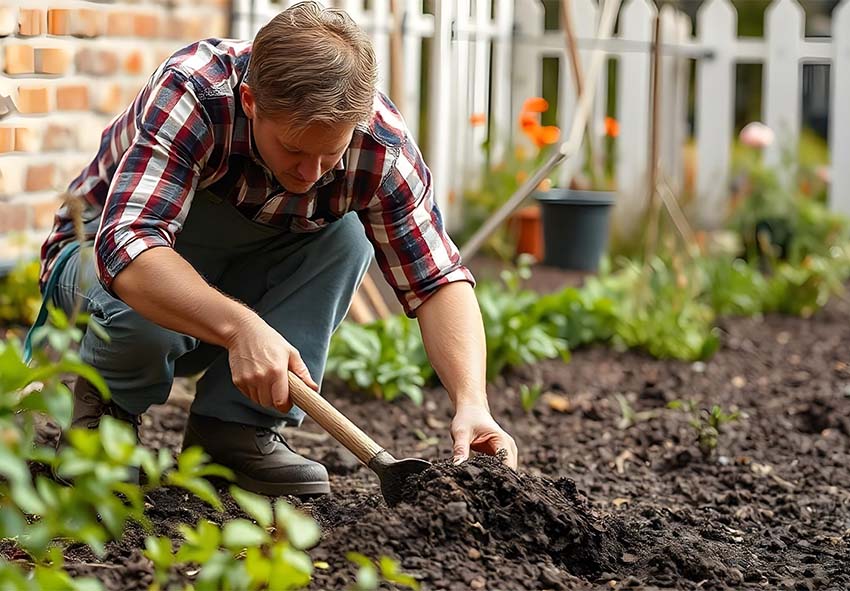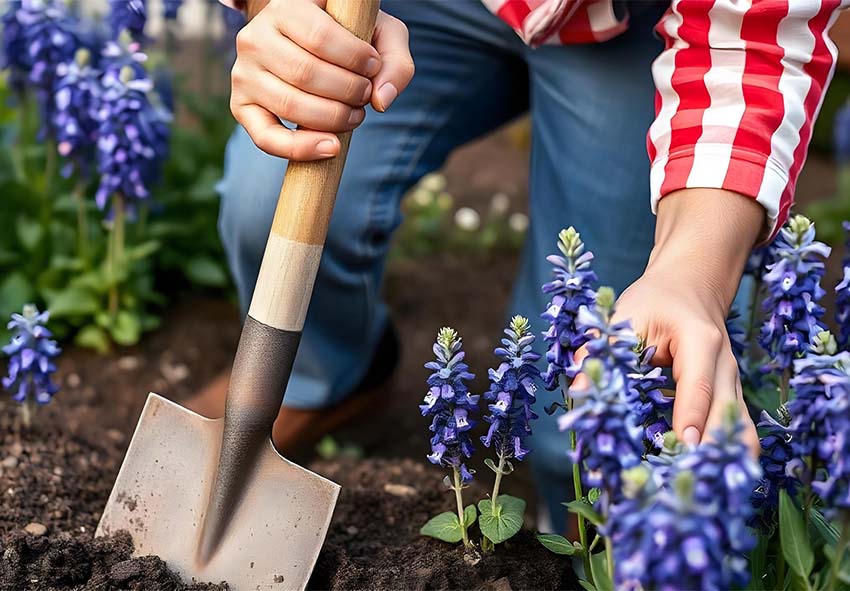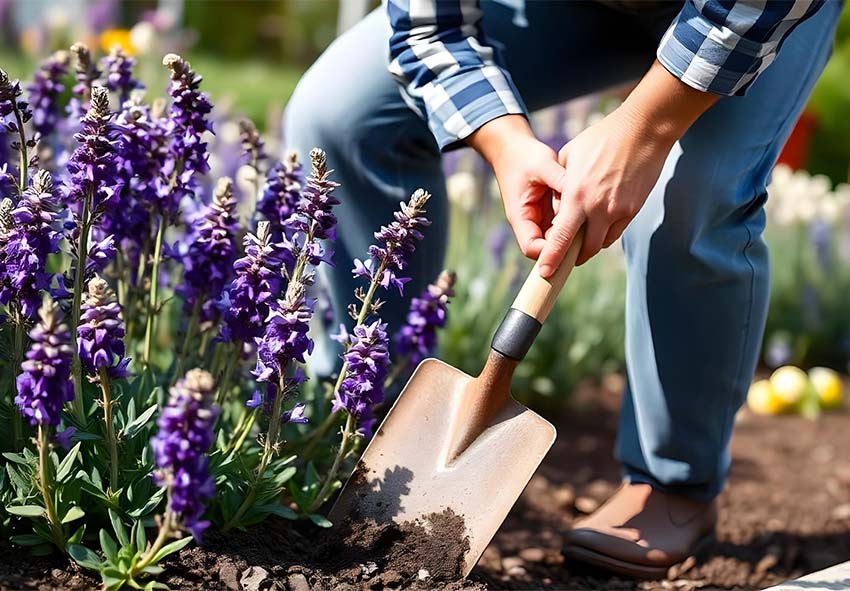Salvia, a beloved plant in gardens worldwide, is known for its vibrant blooms and versatility. Whether you’re cultivating a pollinator-friendly garden or seeking low-maintenance perennials, Salvia is an excellent choice. However, successful planting requires careful preparation, from choosing the right time and location to understanding the plant’s specific needs. This guide will walk you through the essential steps for planting Salvia, ensuring your garden thrives with these beautiful plants. Our gardening blog is a perfect place to find all the information you need!
Preparing to Plant Salvia

Before you begin planting Salvia, it’s important to prepare properly. This involves choosing the best time and location, understanding the plant’s light and soil needs, and making necessary soil amendments. A little preparation goes a long way in creating the perfect environment for your Salvia to flourish.
Best Time to Plant Salvia
The best time to plant Salvia largely depends on your climate and the specific species you’re working with. In most regions, spring is ideal, as the soil is warming up and there’s no risk of frost. For species that prefer cooler weather, fall planting can also be successful, especially in warmer climates where winters are mild. Understanding the growth habits of your chosen Salvia species is crucial for determining the optimal planting time.
Choosing the Right Location
When choosing the right location for planting Salvia, there are two main factors to consider:
Sunlight Requirements:
- Select a location that provides at least 6 hours of direct sunlight daily.
- Some Salvia species can tolerate partial shade, but full sun is ideal for most varieties.
- In hotter climates, choose a spot that offers protection from the harsh afternoon sun.
Soil Type and Drainage:
- Salvia prefers well-drained soil to prevent root rot.
- If your garden has heavy clay or poor drainage, consider amending the soil with organic matter or sand.
- Raised beds are an excellent option to improve drainage and ensure healthy root development.
Preparing the Soil
Before planting Salvia, it’s important to prepare the soil to meet the plant’s needs. Salvia thrives in slightly acidic to neutral soil, with a pH ranging from 6.0 to 7.0. Conduct a soil test to determine your garden’s pH and nutrient levels. If adjustments are needed, lime can raise pH, while sulfur can lower it. Additionally, enrich the soil with organic matter such as compost or well-rotted manure to improve its structure and fertility, ensuring your Salvia plants have the nutrients they need to grow strong and healthy.
Step-by-Step Guide to Planting Salvia

Planting Salvia is straightforward, but following a step-by-step process ensures that your plants thrive. From selecting the right seeds or transplants to correctly spacing and watering them, each stage plays an essential role in the overall health and beauty of your Salvia. Additional planting tips are available in a full guide for Salvia. This guide will walk you through the entire planting process.
How to Plant Salvia Seeds
Planting Salvia from seeds offers gardeners flexibility in timing and variety selection. Here are some main tips for planting your Salvia seeds:
- Choose the Right Time to Plant: Start Salvia seeds indoors 6-8 weeks before the last expected frost, or sow them directly outdoors in late spring when the soil has warmed up.
- Prepare Seed Trays or Garden Beds: Use seed trays filled with a light, well-draining seed-starting mix, or prepare garden beds by loosening the soil and adding compost for added nutrients.
- Sow the Seeds: Scatter Salvia seeds thinly over the surface of the soil, pressing them lightly to ensure good seed-to-soil contact. Salvia seeds need light to germinate, so do not cover them with soil.
- Water Gently: Mist the soil lightly with water to avoid washing the seeds away. Keep the soil consistently moist but not soggy during the germination period.
- Provide Adequate Light: Place the seed trays under a grow light or in a sunny window, ensuring they receive at least 6-8 hours of light daily. If planted outdoors, ensure the area gets plenty of sunlight.
- Monitor Germination: Salvia seeds typically germinate in 10-14 days. Keep an eye on the moisture level and light conditions during this period to ensure successful sprouting.
Planting Salvia from Seedlings or Transplants
If you’re planting Salvia seedlings or transplants, begin by digging holes that are twice as wide as the root ball but not deeper. This allows the roots to spread out and establish themselves easily. Place the plant in the hole, ensuring the top of the root ball is level with the surrounding soil. Space the plants according to the variety’s mature size—typically 12-18 inches apart. This spacing allows for proper air circulation, which is crucial for preventing fungal diseases. Gently firm the soil around the plant and water thoroughly.
Watering After Planting
After planting Salvia, water the plants thoroughly to help establish their roots. The key is to maintain soil moisture without overwatering, which can lead to root rot. In the first few weeks, water the plants deeply once or twice a week, depending on rainfall and temperature. As the plants become established, they will need less frequent watering, especially if grown in well-drained soil.
Avoiding Common Mistakes When Planting Salvia

When planting Salvia, avoiding common pitfalls is crucial to ensure healthy growth and vibrant blooms. Understanding the frequent mistakes that gardeners make—such as improper watering, incorrect planting depth, or choosing the wrong location—can help you take proactive steps to set your plants up for success. Let’s explore how to avoid these issues.
Common Planting Mistakes
Even experienced gardeners can encounter issues when planting Salvia, but knowing how to avoid common mistakes can make a big difference:
- Planting Salvia in Poorly Drained Soil: Salvia plants are highly susceptible to root rot in waterlogged soil, leading to stunted growth and eventual plant death.
- Overwatering or Underwatering: Both overwatering and underwatering can stress Salvia plants, causing yellowing leaves, root rot, or dehydration.
- Incorrect Planting Depth: Planting Salvia too deeply or too shallow can hinder root establishment and result in weak, unhealthy plants.
- Choosing the Wrong Location: Placing Salvia in a spot with too much shade or poor soil can limit its growth and flowering potential.
How to Fix Them
Addressing common planting mistakes is key to ensuring the healthy growth of your Salvia plants. Whether it’s improving soil drainage, establishing a proper watering routine, or correcting planting depth, taking the right steps can help you overcome these issues and promote vigorous growth and abundant blooms. Here’s how to fix the most common planting mistakes:
- Improve Soil Drainage: To fix poorly drained soil, amend it with organic matter like compost or sand to enhance drainage. Alternatively, consider planting Salvia in raised beds or mounded areas.
- Establish a Proper Watering Routine: Water Salvia thoroughly after planting, then adjust watering frequency based on soil moisture. Use mulch to retain moisture and prevent the soil from drying out too quickly.
- Ensure Correct Planting Depth: Plant Salvia at the same depth as it was in the pot or slightly deeper for seeds. Make sure the root ball is covered with soil, but avoid burying the stem too deep.
- Relocate to a Suitable Spot: If Salvia is planted in an unsuitable location, transplant it to an area that receives full sun and has well-drained soil. Avoid low-lying areas prone to water accumulation.
Conclusion
Planting Salvia successfully involves careful consideration of timing, location, and soil preparation. By following these guidelines, you can create a garden that not only showcases the beauty of Salvia but also thrives season after season. Whether you’re starting your first garden or adding to an existing one, Salvia offers a rewarding gardening experience. To explore more gardening tips and find high-quality Salvia varieties, visit our online plant store.
Frequently Asked Questions (FAQs) about Planting Salvia
1. When is the best time to plant Salvia?
The ideal time to plant Salvia is in the spring after the last frost when the soil has warmed up. For areas with mild winters, fall planting is also an option, allowing the roots to establish before the cooler weather. Timing ensures healthy growth and abundant blooms.
2. Can Salvia grow in partial shade?
While Salvia thrives in full sun, receiving at least 6 hours of direct sunlight daily, some species can tolerate partial shade. However, in too much shade, Salvia may become leggy and produce fewer flowers. For best results, choose a spot with ample sunlight to encourage vigorous growth and blooming.
3. What type of soil does Salvia prefer?
Salvia prefers well-drained soil with a slightly acidic to neutral pH. If your garden soil is heavy clay or poorly draining, amend it with organic matter or sand to improve drainage. Well-drained soil prevents root rot and supports healthy plant development, ensuring your Salvia thrives.
4. How deep should Salvia seeds be planted?
Salvia seeds should be sown on the soil’s surface and pressed lightly to ensure good seed-to-soil contact. They should not be covered with soil, as they need light to germinate. Keeping the soil consistently moist and providing adequate light will help the seeds sprout successfully.
5. Can I order dutch Salvia from your online store?
Yes, we offer a wide selection of Salvia, including some varieties originating from Holland, renowned for their quality and beauty. Our online store Dutch-bulbs.com features a diverse range of Salvia. Explore our collection to find the perfect Salvia varieties for your garden or landscaping projects.
Published: 10.10.2024
